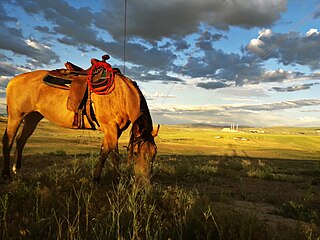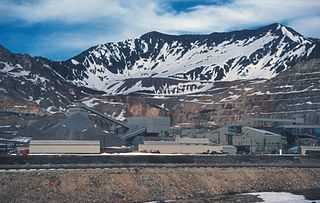Dayton is an extinct town in Lake County, Colorado, located on the site of what is now Twin Lakes. Like the larger nearby towns of Granite and Oro City, Dayton formed rapidly during the Pike's Peak Gold Rush and failed quickly when the local mining industry collapsed. [1] The Dayton post office operated from October 16, 1866, until November 30, 1868. [2] Dalles was made the Lake County seat from 1868 to 1868. At its peak, [3] [4] it had hotels, a general store, a courthouse, and a post office and served as the county seat. [5] Dayton's courthouse was taken down and moved to Granite by early 1869. [5] In the decade after Dayton's demise, the area became a vacation destination appreciated for its scenery, hunting, and fishing. [5]
Prior to European exploration and colonization, the land was inhabited by the Ute people. [1]

Leadville is a statutory city that is the county seat, the most populous community, and the only incorporated municipality in Lake County, Colorado, United States. The city population was 2,633 at the 2020 census. It is situated at an elevation of 10,158 feet (3,096 m). Leadville is the third highest incorporated city in the United States behind Alma and Montezuma and is surrounded by two of the tallest peaks in the state.

Moffat County is a county located in the U.S. state of Colorado. As of the 2020 census, the population was 13,292. The county seat is Craig. With an area of 4,751 square miles, it is the second-largest county by area in Colorado, behind Las Animas County.

Lake County is a county located in the U.S. state of Colorado. As of the 2020 census, the population was 7,436. The county seat and the only municipality in the county is Leadville. The highest natural point in Colorado and the entire Rocky Mountains is the summit of Mount Elbert in Lake County at 14,440 feet elevation.

Red Cliff is a statutory town in Eagle County, Colorado, United States. The population was 257 at the 2020 census. The town is a former mining camp situated in the canyon of the upper Eagle River just off U.S. Highway 24 north of Tennessee Pass. The town site is concealed below the highway and is accessible by a side road leading to Shrine Pass in the Sawatch Range. It was founded in 1879 during the Colorado Silver Boom by miners from Leadville who came over Tennessee Pass scouting for better prospects. The name derives from the red quartzite cliffs surrounding the town. As the first community in the Eagle Valley, it served temporarily as the first county seat of Eagle County until the relocation of the county seat to Eagle in 1921.

The Sawatch Range or Saguache Range is a high and extensive mountain range in central Colorado which includes eight of the twenty highest peaks in the Rocky Mountains, including Mount Elbert, at 14,440 feet (4,401 m) elevation, the highest peak in the Rockies.
The Top of the Rockies National Scenic Byway is a National Scenic Byway and Colorado Scenic and Historic Byway located in the high Rocky Mountains of Eagle, Lake, Pitkin, Summit counties, Colorado, United States. The 115-mile (185 km) byway showcases the two highest peaks of the Rocky Mountains: Mount Elbert at elevation 14,440 feet (4,401.2 m) and Mount Massive at elevation 14,428 feet (4,398 m). The byway connects with the Collegiate Peaks Scenic Byway at the junction of Colorado State Highway 82 and U.S. Highway 24.

Twin Lakes is a pair of glacier-carved alpine lakes about 15 miles (24 km) south of historic Leadville, Colorado. They are downstream along the Arkansas River, whose headwaters are by Leadville. The lakes, however, are on a tributary, Lake Creek, which joins the Arkansas just below the lakes. After dredging, the lakes now have a surface area of 2,700 acres (11 km2), and they serve as a reservoir to store water for use in the Front Range. Both east and west lakes are recreation areas for boating and fishing.

Granite is an unincorporated community with a U.S. Post Office in Chaffee County, Colorado, United States. The zip code of Granite is 81228. According to the 2010 census, the population is 116.

Oro City is a ghost town in Lake County, Colorado, United States

Buckskin Joe, also called Laurette or Lauret, is a deserted ghost town in Park County, Colorado, United States. It was an early mining town, and the former county seat of Park County.

The Climax mine, located in Climax, Colorado, United States, is a major molybdenum mine in Lake and Summit counties, Colorado. Shipments from the mine began in 1915. At its highest output, the Climax mine was the largest molybdenum mine in the world, and for many years it supplied three quarters of the world's supply of molybdenum.

Independence is a ghost town in the U.S. state of Colorado. It is located just off State Highway 82 in the eastern corner of Pitkin County, below the Continental Divide. It was the first settlement established in the Roaring Fork Valley, after gold was struck in the vicinity on Independence Day, July 4, 1879, hence its name. In 1973 it was recognized as a historic district and listed on the National Register of Historic Places as Independence and Independence Mill Site, one of two ghost towns in the county so recognized. It has also been known historically by other names—Chipeta, Mammoth City, Mount Hope, Farwell, Sparkill and Hunter's Pass.
Adelaide is a mining ghost town in Lake County, in the U.S. state of Colorado. The site of the former town is located about one mile west of downtown Leadville through Stray Horse Gulch and two-thirds of a mile north of Nugget Gulch.

This is a population history of the 210 census-designated places in the US state of Colorado since the 2000 United States census. The United States Census Bureau defines certain unincorporated communities as census-designated places (CDPs) for enumeration in each decennial census. The Census Bureau defined 85 CDPs in Colorado for the 2000 Census, 187 CDPs for the 2010 Census, and 210 CDPs for the 2020 Census.